| The Appalachian Trail - An Adventure of a Lifetime
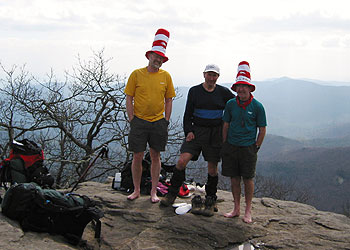 Everybody has dreams, I mean that is probably what makes us different from animals. I think this one started about 10 or 12 years ago. Bruce Duffy had invited some of us down to "hike" the White Mountains of New Hampshire. This wasn't your classic hike ~ tents and sleeping bags and food cooked over an open fire. This was to do some nice walking up and over 5000' mountains and then stay in a "hut", which serves supper and breakfast before continuing on to the next hut. Now these huts are big enough to serve anywhere from 80 to 100 people and put them up for the night on bunks.
Everybody has dreams, I mean that is probably what makes us different from animals. I think this one started about 10 or 12 years ago. Bruce Duffy had invited some of us down to "hike" the White Mountains of New Hampshire. This wasn't your classic hike ~ tents and sleeping bags and food cooked over an open fire. This was to do some nice walking up and over 5000' mountains and then stay in a "hut", which serves supper and breakfast before continuing on to the next hut. Now these huts are big enough to serve anywhere from 80 to 100 people and put them up for the night on bunks.
We met a thru-hiker, who explained that he was actually walking from Georgia to Maine over the Appalachian Trail (AT), a distance of about 2170 miles. It just seemed to catch my imagination. I had hiked with the boy scouts, as a leader, and done as much as 25 K in a day, and back when I was in shape, it really wasn't that hard and certainly all sorts of fun. This was a going to be a challenge, but certainly doable.
I have always looked for challenges. I ran 100 mile races when there were 100's of runners in Nova Scotia better than me, but people said they couldn't do them "Too long" I said "Why not?" Gee, if you train for it and make a plan and follow that plan, you have a reasonable chance of success. The first 100 miler in Vermont was brutal and I completed it in 27 hrs. If you complete it in under 24 hrs, you get a belt buckle. Well I returned the next year and still wear that buckle every day.
I had originally thought that I could take 6 months sabbatical and hike the trail, but it seems that Human Resources could never a calculate what my cheque would be for the 3 or 4 years preceding when you take partial salary. Then in Feb '00, I received a job offer from outside government that would allow me to make enough to leave in the spring of '03.
I started doing a lot more reading and studying for the trip. This is a six month trip that required a lot of planning, from your gear, to your food, to your schedule. It had to include how to communicate back home (phone and e-mail) and medicine. It had to include whether we would use "food drops" and how many and where. It had to include getting in shape to walk for 10 to 15 miles a day with a 45~50# pack on your back up and down some significant hills.
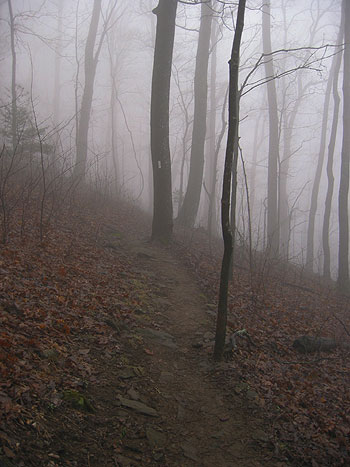 I started reading other peoples' journals on Trailjournals.com to see how they did it and what they felt. I read every journal that described the parts of the trail that I had already done. How did they find that hill? We found the toughest parts in New Hampshire and Maine. We hiked the "toughest mile" (it took us almost 3 hours same as them) on the AT to see what it was like. We hiked the toughest day on the AT ( and didn't finish until almost 8 at night in the dark) to see what it was like. The year before we left, we hiked the "100 Mile Wilderness" in Maine, to see what it would be like to hike for 7 days and have no available services nearby the whole time. Also in the last year, I read 3 or 4 journals of people who had started on the same date we were going to start. What kind of weather would they get?
I started reading other peoples' journals on Trailjournals.com to see how they did it and what they felt. I read every journal that described the parts of the trail that I had already done. How did they find that hill? We found the toughest parts in New Hampshire and Maine. We hiked the "toughest mile" (it took us almost 3 hours same as them) on the AT to see what it was like. We hiked the toughest day on the AT ( and didn't finish until almost 8 at night in the dark) to see what it was like. The year before we left, we hiked the "100 Mile Wilderness" in Maine, to see what it would be like to hike for 7 days and have no available services nearby the whole time. Also in the last year, I read 3 or 4 journals of people who had started on the same date we were going to start. What kind of weather would they get?
We left Halifax on Sunday night Mar 16th and caught the Greyhound Bus from Bangor on Monday at noon. After a very painful trip of 34 hours we got off in Atlanta, Georgia. Our shuttle, who had hiked the trail the year before, was waiting for us. After stopping for some groceries, we were at the trailhead in about 2 hours. On Wed the 19th, after a fitful sleep, we were up and off by 8:30 in the morning.
March in Georgia is a little bit different than in Nova Scotia. While it rained and was misty for the first couple of days it started to get warm. Now the woods in Georgia are a little bit different than here. No softwood trees at all. The sun beat down on us as there no vegetarian cover at all. I had severe sun burn on my right arm, so bad that I wrapped it with a bandana. The really impressive thing about spending six months in the woods is you really get to study what is around you. The flowers slowly start to emerge and the leaves slowly start to come out.
The first small flowers struggling to come up through the dead leaves from the previous year. The only colour on the forest floor. The birds, that you so often take for granted, the small chipmunks and squirrels. Every sense ~ now that much more in tune with what is going on around you. We started slowly, only averaging 8 miles/ day in March. But we were on a high. We had allowed 180 days and there was no hurry. All the thru-hikers that we had communicated with, emphasized that it is not the end but the journey that was the experience. They all said when it was over, they wished that they hadn't been so quick.
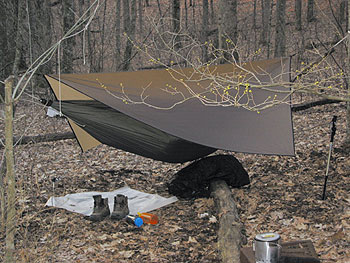 In the first shelter, on the first night, there were about 14 others as well as another 5 or 6 tenting outside. While this is a wilderness trail, there is no shortage of other people trying to do the same thing. We met other hikers from 14 yrs old to more than 70 yrs old. Everybody shares all that they have. Running low on food, someone has more that they need. Water ~ same thing, fuel ~ same thing again. We quickly found the good and the bad in shelters. You really don't fall asleep until the last guys stop talking and you wake when the first guys wake. So the first night the talking stopped a little after midnight and the first guys were up before 5. We tented for the next couple of weeks, as you then fell asleep when you wanted and woke when you wanted.
In the first shelter, on the first night, there were about 14 others as well as another 5 or 6 tenting outside. While this is a wilderness trail, there is no shortage of other people trying to do the same thing. We met other hikers from 14 yrs old to more than 70 yrs old. Everybody shares all that they have. Running low on food, someone has more that they need. Water ~ same thing, fuel ~ same thing again. We quickly found the good and the bad in shelters. You really don't fall asleep until the last guys stop talking and you wake when the first guys wake. So the first night the talking stopped a little after midnight and the first guys were up before 5. We tented for the next couple of weeks, as you then fell asleep when you wanted and woke when you wanted.
By the time we hit the Great Smokey Mountains National Forest, we pretty much had the hang of it. Now the border of Tennessee and North Carolina follows the ridge of the Appalachian Mountains. This is also the AT, so when your right foot touches down you are in North Carolina and when your left foot touches you are in Tennessee. The shelters in the Smokeys have chain link fences that you close up when you get inside them to protect you from the bears. Our first night in the Smokeys, we didn't make the shelter in time to get one of the spots for the night, so we set up our tents outside. It was a little unnerving to be outside while the rest were safely inside behind the fence. As with most things, the secret was to hang your food in a bear bag away from your tent.
Our second snow storm hit us here on our last night, as about 6" fell during the night and another 6" before we got out. We hitched a ride into town and dried out and did the laundry and bought food for the next section.
When we did the Shenandoahs, we saw our first bear. It was running away as fast as it could. We actually managed to get within about 15 metres of the second before he finally smelled us and ambled off fairly slowly. Here we came upon newborn fawns still trying to stand for the first time.
At the mental half way point, at Harper's Ferry, when we signed in, we found we were #'s 256 and 257 to reach that far. 50 miles farther, we made the actual half way point and there is a tradition that some thru-hikers try to eat a half gallon of ice cream to celebrate. Not many try and fewer manage to finish. It was hard but just one of the fun challenges to do.
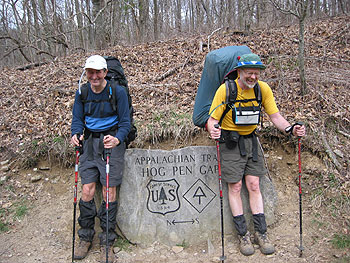 I have to mention "Trail Magic". This is an extremely nice part of the whole experience, where people put out apples or chocolate bars or pop, for hikers to consume. It is also where people offer rides into town and relish the idea of helping out a very smelly bunch of hikers. A group actually roasted a leg of lamb for us at one spot.
I have to mention "Trail Magic". This is an extremely nice part of the whole experience, where people put out apples or chocolate bars or pop, for hikers to consume. It is also where people offer rides into town and relish the idea of helping out a very smelly bunch of hikers. A group actually roasted a leg of lamb for us at one spot.
There are hostels all along the AT, from a log cabin to a huge stone house, and everything in between. Some ask for donations and some charge(?) $10 or $12, Some have kitchen facilities and some serve meals. Some have bunks and some a piece of floor. All are managed by a fantastic bunch of people, that will do anything for you. The log barn that we stayed at was owned and run by an 85 year old widow who had been doing this with her husband for 20 years and continued when he passed away 15 years ago. She served an all you could eat (AYCE) breakfast and charged a whopping $3.00.
As we traveled north, the terrain became more like home with fir and pine and spruce. We did see rattlesnakes and they are pretty impressive at more than 5' long. The first one we heard gave us about 15' of warning and the locals call them "gentlemen snakes" for that reason.
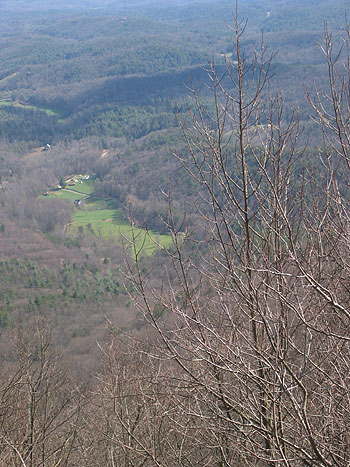 When we hit Vermont and the White Mountains of New Hampshire, we knew we were getting close. About 15 of our friends and wives had come down to do a bit of hiking with us and it was certainly nice to see them. For some reason, only Bruce Murphy could hang with us and then for only the first day. We did manage to do 100 miles in 6 days over this challenging terrain albeit without packs which certainly made it easier.
When we hit Vermont and the White Mountains of New Hampshire, we knew we were getting close. About 15 of our friends and wives had come down to do a bit of hiking with us and it was certainly nice to see them. For some reason, only Bruce Murphy could hang with us and then for only the first day. We did manage to do 100 miles in 6 days over this challenging terrain albeit without packs which certainly made it easier.
Maine was beautiful (just like home) and we very made good mileage for the last couple of weeks. Sort of like the horse going back to the barn. The 100 Mile Wilderness, which took us a long 7 days the previous year, we floated through in an easy 6 days.
For the summitting, we were met by Bruce Duffy and Jerome Bruhm from Halifax and Larry Sampson and his daughter, Emma from Fredericton. It started out as a nice warm day at the bottom but after climbing about 3000' it got very misty and windy (I think we were in a cloud). I think the temp on the top was not much above freezing but it didn't seem to matter, this was the culmination of a 10 year dream with 1 year of intense planning and 161 days of actually being on the trail. The trip back down was anti-climatic. It really was the actual 161 days of the hike that we will remember and not the last day. It was a great adventure but 6 months away from home is toooooo looong. I would do it again but only if my wife, Nancy, wanted to come along.
|